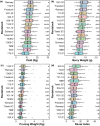Grapevine rootstocks affect growth-related scion phenotypes
- PMID: 34095741
- PMCID: PMC8156960
- DOI: 10.1002/pld3.324
Grapevine rootstocks affect growth-related scion phenotypes
Abstract
Grape growers use rootstocks to provide protection against pests and pathogens and to modulate viticulture performance such as shoot growth. Our study examined two grapevine scion varieties ('Chardonnay' and 'Cabernet Sauvignon') grafted to 15 different rootstocks and determined the effect of rootstocks on eight traits important to viticulture. We assessed the vines across five years and identified both year and variety as contributing strongly to trait variation. The effect of rootstock was relatively consistent across years and varieties, explaining between 8.99% and 9.78% of the variation in growth-related traits including yield, pruning weight, berry weight and Ravaz index (yield to pruning weight ratio). Increases in yield due to rootstock were generally the result of increases in berry weight, likely due to increased water uptake by vines grafted to a particular rootstock. We demonstrated a greater than 50% increase in yield, pruning weight, or Ravaz index by choosing the optimal rootstock, indicating that rootstock choice is crucial for grape growers looking to improve vine performance.
Keywords: grafting; grapevines; rootstocks; root‐shoot interactions.
© 2021 The Authors. Plant Direct published by American Society of Plant Biologists and the Society for Experimental Biology and John Wiley & Sons Ltd.
Conflict of interest statement
PC, LMJ, and RKS were employed by E. & J. Gallo Winery. The remaining authors declare that the research was conducted in the absence of any commercial or financial relationships that could be construed as a potential conflict of interest.
Figures





References
-
- Amerine, M. A. , & Ough, C. S. (1980). Methods for analysis of musts and wines. Wiley‐Interscience.
-
- Antcliff, A. (1965). A comparison of cropping levels in the Sultana. Published Online.
-
- Cheng, J. , Wei, L. , Mei, J. , & Wu, J. (2017). Effect of rootstock on phenolic compounds and antioxidant properties in berries of grape (Vitis vinifera L.) cv. ‘Red Alexandria’. Scientia Horticulturae, 217, 137–144. 10.1016/j.scienta.2017.01.037 - DOI
-
- Christensen, C. P. , Kasimatis, A. N. , & Jensen, F. L. (1978). Grapevine nutrition and fertilization in the San Joaquin Valley. Division of Agriculture and Natural Resources, University of California.
-
- Cirami, R. , McCarthy, M. , & Glenn, T. (1984). Comparison of the effects of rootstock on crop, juice and wine composition in a replanted nematode‐infested Barossa Valley vineyard. Australian Journal of Experimental Agriculture, 24(125), 283–289. 10.1071/EA9840283 - DOI
LinkOut - more resources
Full Text Sources

